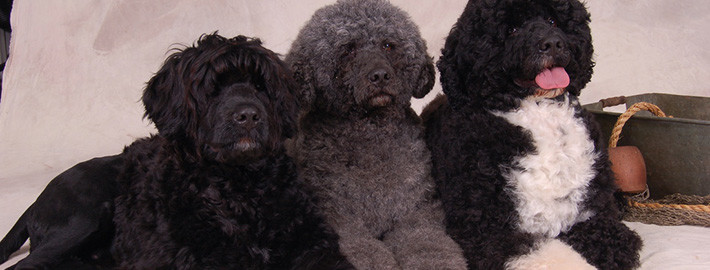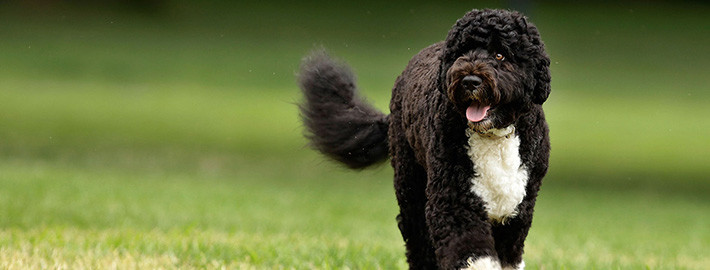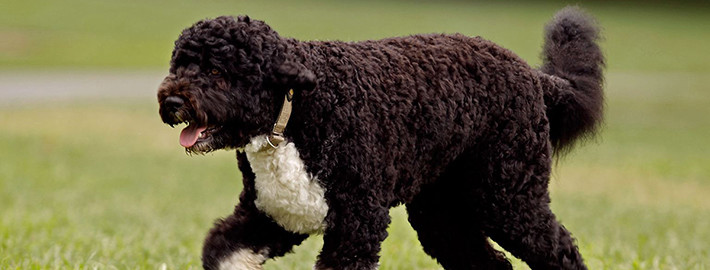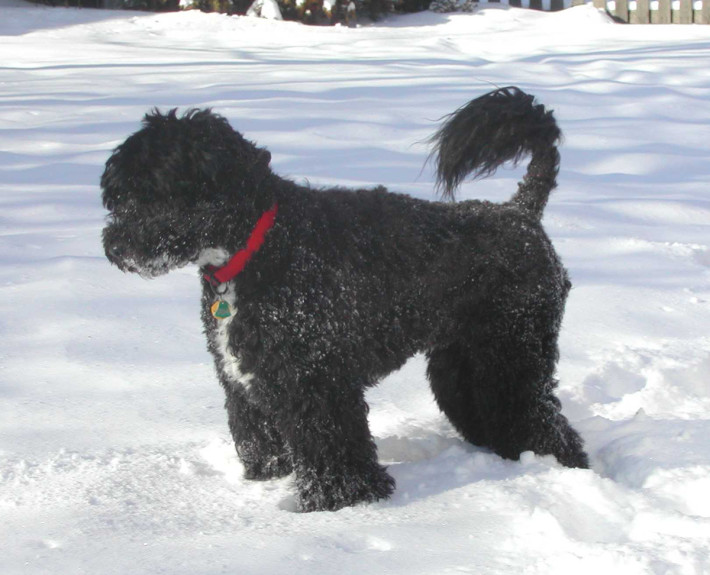What makes the Portuguese Water Dog Unique?
The Portuguese water dog is a robust dog of medium build, slightly longer than it is tall. It is strong and well-muscled, able to work both in and out of the water for long periods. It has a profuse single coat, either wavy or curly. Two clips are acceptable: the lion clip, in which the muzzle and middle part, up to the tail tip, are clipped; and the retriever clip, in which the entire coat is scissored to about 1 inch in length, with the tail tip again left full length. The water dog’s expression is steady, penetrating and attentive, reflecting its spirited disposition. The gregarious Portuguese water dog is a fun-loving, family-loving, water-loving dog. It is good with children, and other dogs and pets. It is sensitive and responds well to direction. It is a good breed for an active person wanting an adventurous, affectionate, biddable partner.
Breed Groups
Page Contents
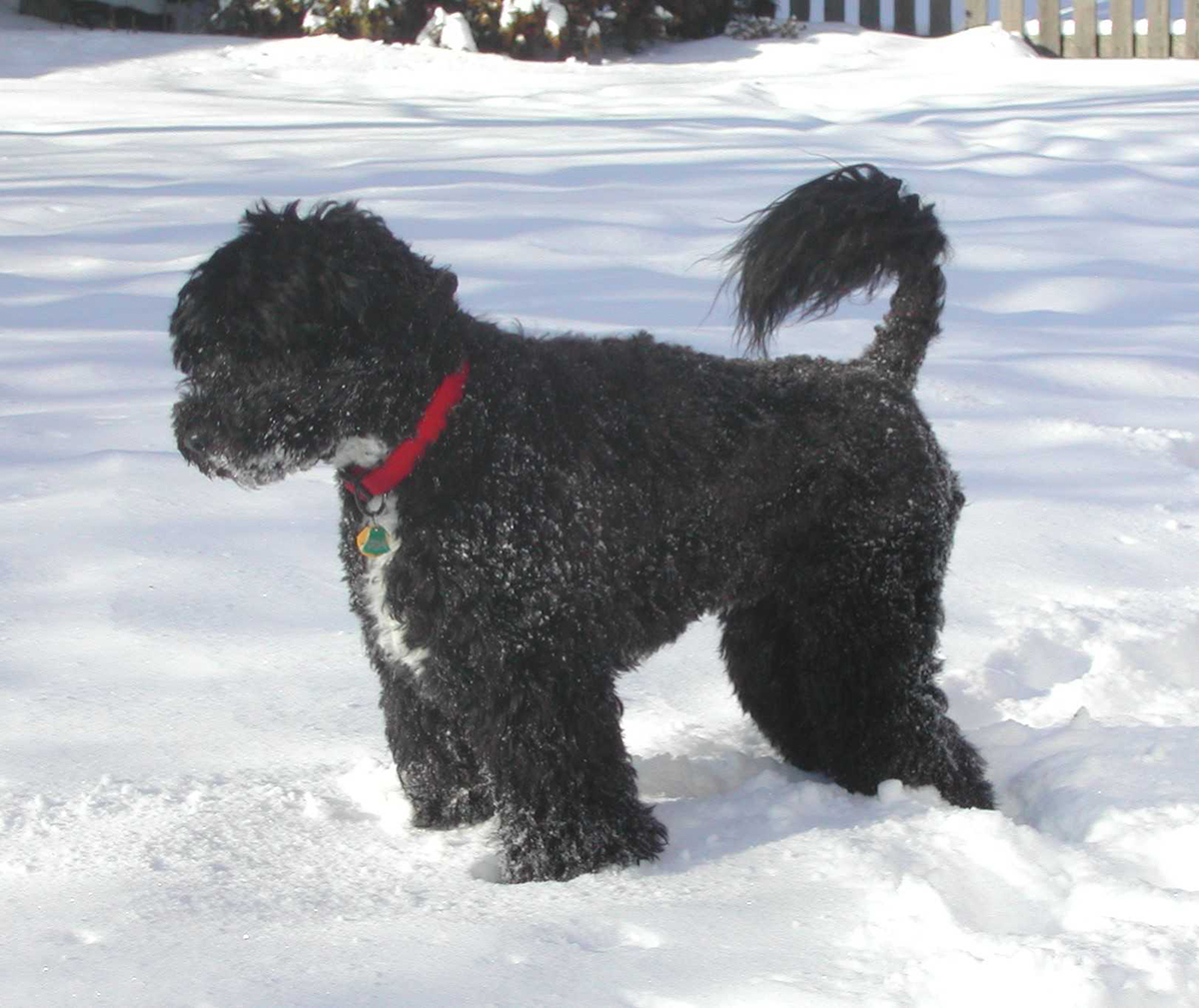
Is the Portuguese Water Dog Right For You?
An athletic, active breed, the Portuguese Water Dog requires daily vigorous exercise. He is very intelligent and responds well to obedience training. His profuse coat is hypoallergenic, but requires regular maintenance. It may be kept in the lion clip (the coat on the hindquarters and muzzle are clipped to the skin) or the retriever clip (the entire coat is clipped to one inch in length and follows the outline of the dog). If you are considering purchasing a Portuguese Water Dog puppy, learn more. *Working Group; AKC recognized in 1983.
*Ideal size: 35 to 60 pounds and 17 to 23 tall inches at the shoulder.
* Fisherman’s working companion; family pet.
In 5 Words
- Obedient
- Docile
- Brave
- Intelligent
- Impetuous
Characteristics
Learn About the Portuguese Water Dog
Description
The Portuguese Water Dog is a medium-sized, muscular dog. The topline is straight and level. The broad, domed head is slightly longer then the muzzle. The muzzle has a well-defined stop. The black nose is broad. The teeth meet in a scissors or level bite. The medium-sized, round eyes are dark. The heart-shaped ears are set high and hanging. The tail is not docked to aid in swimming, is thicker at the base and tapering. Dewclaws are sometimes removed. The legs are straight. The feet are webbed which aids the dog in swimming. The single-layered coat is thick and is either curly or wavy in texture. Coat colors come in black, white, various shades of brown, parti-colors of white with dark spots, black or brown with white markings, silver fox and gray.
Short History of the Portuguese
The Portuguese Water Dog (also known as the ‘Cao de Agua Portuguese’, commonly called the ‘Portie’, ‘PWD’, or ‘Water Dog’) shares its early ancestry with the Poodle. It descends from Asian herding breeds brought to Portugal either with the Goths in the fifth century or the Berbers in the eighth century. In Portugal, it was adapted for all manner of water activities, such as herding fish into nets, retrieving lost fishing equipment, and delivering messages to ship or to shore. The Portuguese Water Dog declined in numbers as fishing methods modernized, but in the 1930’s wealthy shipping magnate Dr. Vasco Bensuade helped to standardize and promote it. Dr. Bensuade became captivated by the breed after witnessing a Portuguese Water Dog named Leao dive through icy waters on command. The Portuguese Water Dog was recognized by the American Kennel Club in 1984 and is today increasing in popularity as a pet, but still a fairly rare show breed. Sen. Ted Kennedy’s Portuguese Water Dog ‘Splash’ is the narrator of his book ‘My Senator and Me: A Dog’s-Eye View of Washington, D.C.’. Portuguese Water Dogs make up the Baseball Aquatic Retrieval Korps (B.A.R.K.), a team of dogs which retrieves home run balls hit by the San Francisco Giants into neighboring McCovey Cove, with proceeds donated to charity. A female Portuguese Water Dog named Girella is known for being photographed with numerous musicians such as ‘Franz Ferdinand’ and ‘Death Cab for Cutie’.
Temperament
Portuguese Water dogs make excellent companions. They are loving, independent, and intelligent and are easily trained in obedience and agility skills. Once introduced, they are generally friendly to strangers, and enjoy being petted, which, due to their soft, fluffy coats, is a favour that human beings willingly grant them.
Because they are working dogs, PWDs are generally content in being at their master’s side, awaiting directions, and, if they are trained, they are willing and able to follow complex commands. They learn very quickly, seem to enjoy the training, and have a long memory for the names of objects. These traits and their non-shedding coats mean they excel at the various Service Dog roles such as hearing dogs (assistance dogs for the deaf), mobility dogs, and seizure response dogs. They also make unusually good therapy dogs.
A PWD usually stays in proximity to its owners, indoors as well as outdoors. This is typical of the breed. Though very gregarious animals, these dogs will typically bond with one primary or alpha family member. Some speculate that this intense bonding arose in the breed because the dogs were selected to work in proximity to their masters on small fishing boats, unlike other working dogs such as herding dogs and water dogs that range out to perform tasks. In any case, the modern PWD, whether employed on a boat or kept as a pet or a working dog, loves water, attention, and prefers to be engaged in activity within sight of a human partner. This is not a breed to be left alone for long periods of time, indoors or out.
As water dogs, the PWD’s retrieving instinct is strong, which also gives some dogs tugging and chewing tendencies.
A PWD will commonly jump as a greeting. Owners may choose to limit this behavior. Some PWDs may walk, hop, or “dance” on their hind legs when greeting or otherwise enthusiastic. Some PWDs will stand upright at kitchen counters and tables, especially if they smell food above them. This habit is known as “counter surfing” and is characteristic of the breed. Although it can be a nuisance, many PWD owners evidently enjoy seeing their dogs walking, hopping, standing up, or “countering” and do not seriously discourage these activities.
While they are very good companions to people who understand what they need, Portuguese Water Dogs are not for everyone. Because of their intelligence and working drive, they require regular intensive exercise as well as mental challenges. They are gentle and patient — but not “couch potatoes”, and boredom may cause them to become destructive.
Caring for Your Portuguese Water Dog
Grooming & Bathing
The Portuguese Water dog should be brushed and combed regularly. Primarily coat type does not determine which trim they are put in. It is a personal preference. Two coat clips are used: One clip with the face and rear shaved, and the working retriever or pet clip where the dog is scissored so the coat appears to be about an inch long all over. This breed is virtually hypo-allergenic and good for allergy sufferers. The coat sheds little to no hair. The coat grows more slowly than that of apoodle and does not require as frequent scissoring or clipping.
Exercise & Training
The Portuguese Water Dog is an active, working type dog with great stamina. It needs daily physical and mental exercise, which includes a daily, long, brisk walk or jog to satisfy its migration instinct. While out on the walk the dog must be made to heel beside or behind the person holding the lead, as in a dog’s mind the leader leads the way, and that leader needs to be the human. This breed does best with a job to do. They love to swim and there is nothing your dog would love more than if you threw a stick or ball in water for it to retrieve. The Portuguese Water Dog’s intelligence and fondness for hard work makes training a fairly simple matter. Portuguese Water Dogs are quick to understand instructions.

